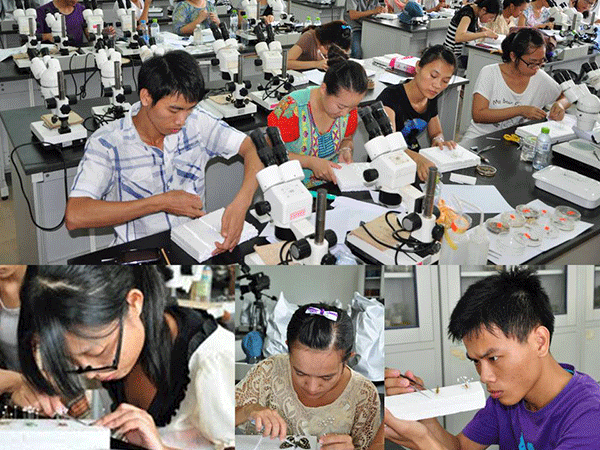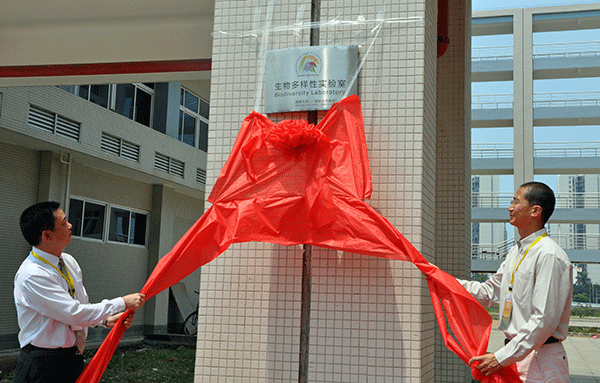by
Hui Zhang and Qianhua Yuan, Hainan University, Hai Kou, China
Monina Escalada, Visayas State University, Leyte, Philippines

Hainan University student interviewing a woman farmer in Haikou, Hainan province, December 2010.
In June 2012, a baseline survey of rice farmers in Hainan reported farmer respondents’ knowledge gaps and attitudes toward ecological engineering techniques. Most of the respondents were uncertain about outbreak factors such as high fertilizer rates and insecticides. Also, while respondents’ attitudes toward ecological engineering techniques seemed positive about two-thirds of them indicated that they were not willing to plant wild flowers or beneficial plants on their rice bunds as it would require more work.
To enhance biodiversity conservation in Hainan, ecological engineering principles need to be communicated to farmers using a combination of communication media including posters, radio, television, video, billboards, leaflets, mobile phones, web-internet and interpersonal channels (demonstration farms, training, field visits). In Vietnam, to scale up ecological engineering, the prototype media materials for the “rice fields with flower bunds” campaign consist of TV broadcast videos, short radio drama episodes, billboards, posters and leaflets (see Escalada & Heong (2012).

Vietnam campaign materials on ecological engineering
When well-planned communication strategies are applied to correct misperceptions, farmers’ resource-management decisions and skills can be improved. Analysis of the audience is an essential part of designing and planning a scaling up program as it will be useful in selecting a cost-effective combination of multi-media channels and in planning the most appropriate use of the media mix to support existing extension activities. To design a scaling-up plan on ecological engineering tailor-made for Hainan rice farmers, we conducted an audience analysis survey among 444 farmers in Haikou and Lingshui cities in Hainan province in July 2012.
The farmers interviewed were about 46 years old and nearly half (48.9%) had lower secondary education. More male farmers (55.6%) than female farmers (44.4%) were interviewed by Hainan University students who were trained to conduct the survey.

Hainan University student interviewing a farmer in Timeng town, Hainan province
Media exposure
In both cities, the big majority (97.3%) of farmers interviewed reported watching TV, followed by using the cell phone (75.5%). More than one-third (37.8%) read printed materials such as newspapers, magazines and books. Less than a fourth (24.3%) listened to radio and 1 out of 10 used the internet.

Hainan farmers reading the newspaper at home with the TV on.
Table 1. Farmers’ media exposure, Hainan, China, 2012.
|
Haikou
|
Lingshui
|
Both
|
| Media exposure* |
No.
|
%
|
No.
|
%
|
No.
|
%
|
| Watch TV |
256
|
57.7
|
176
|
39.6
|
432
|
97.3
|
| Use a cell phone |
199
|
44.8
|
136
|
30.6
|
336
|
75.5
|
| Read newspapers, magazines |
106
|
23.9
|
62
|
14.0
|
168
|
37.8
|
| Listen to radio |
79
|
17.8
|
29
|
6.5
|
108
|
24.3
|
| Use internet |
31
|
7.0
|
30
|
6.8
|
61
|
13.7
|
*Multiple response
Agricultural information sources
Other farmers, extension workers and television topped the list of farming information sources mentioned by farmers. Table 2 shows that less than one-fourth (23%) relied on themselves or their own experience, local authorities (16.2%), and radio (6.5%). A few mentioned the internet (3.6%). Other sources of farm information consisted of pesticide shops, books and video CDs on agricultural science and technology, newspaper, and cell phone.
Table 3 indicates that farmers’ responses were consistent when asked for their preferred sources of agricultural information. Interpersonal sources dominated the list of preferred sources with most respondents specifying other farmers (28.6%), extension workers (25.6%), own experience (16.9%) and television (4.4%). Very few named the internet (2.5%) and radio (2.3%).
Table 2. Farmers’ sources of agricultural information, Hainan, China, 2012.
|
Haikou
|
Lingshui
|
Both
|
| Source* |
No.
|
%
|
No.
|
%
|
No.
|
%
|
| Other farmers |
111
|
25.0
|
86
|
19.4
|
197
|
44.4
|
| Extension worker |
108
|
24.3
|
48
|
10.8
|
156
|
35.1
|
| Television |
81
|
18.2
|
56
|
12.6
|
137
|
30.9
|
| Self or one’s experience |
47
|
10.6
|
55
|
12.4
|
102
|
23.0
|
| Local authorities |
50
|
11.3
|
22
|
5.0
|
72
|
16.2
|
| Radio |
24
|
5.4
|
5
|
1.1
|
29
|
6.5
|
| Internet |
10
|
2.3
|
6
|
1.4
|
16
|
3.6
|
| Other |
2
|
9.5
|
39
|
12.4
|
81
|
18.2
|
*Multiple response
Table 3. Farmers’ preferred sources of agricultural information, Hainan, China, 2012.
|
Haikou
|
Lingshui
|
Both
|
| Source* |
No.
|
%
|
No.
|
%
|
No.
|
%
|
| Other farmers |
74
|
28.4
|
53
|
29.0
|
127
|
28.6
|
| Extension worker |
74
|
28.4
|
38
|
20.8
|
112
|
25.2
|
| Own experience |
37
|
14.2
|
38
|
20.8
|
75
|
16.9
|
| Local authorities |
16
|
6.1
|
11
|
6.0
|
27
|
6.1
|
| Television |
36
|
13.8
|
28
|
15.3
|
64
|
14.4
|
| Internet |
6
|
2.3
|
5
|
2.7
|
11
|
2.5
|
| Radio |
9
|
3.4
|
1
|
0.5
|
10
|
2.3
|
| Other |
6
|
2.3
|
7
|
3.8
|
13
|
2.9
|
*Multiple response
Information source characteristics
We probed farmers why they preferred the information sources they mentioned. A summary of the cross-tabulation of sources and reasons for preference revealed these key characteristics. Farmers expressed relying on themselves because it is more accessible, reliable and no other source is available. In the absence of scientifically-based technical information, delivered in a readily-understandable form through extension workers, farmers often rely largely on their own self-knowledge, beliefs and perceptions. While there are strengths in indigenous knowledge systems, there are also weaknesses and “what farmers don’t know cannot help them” (Bentley, 1989, p.25; DeWalt, 1994).
Other farmers – Easy to contact
Extension worker – Experienced, reliable, accessible, clear and detailed, professional
Self or one’s experience – Accessible, reliable, no other source
Television – Can be received every day, informative, up-to-date
Local authorities – Full-scale
References
Bentley J.W. (1989). What farmers don’t know can’t help them: the strengths and weaknesses of indigenous technical knowledge in Honduras. Agriculture and Human Values, 6, 25-31.
DeWalt B. R. (1994). Using indigenous knowledge to improve agriculture and natural resource management. Human Organization, 53,123-131.
Escalada, M. & Heong, K.L. (2012).. Using decision theory and sociological tools to facilitate adoption of biodiversity -based pest management strategies. Biodiversity and Insect Pests: Key Issues for Sustainable Management, First Edition. Edited by Geoff M. Gurr, Steve D. Wratten, William E. Snyder, Donna M.Y. Read. John Wiley & Sons, Ltd).

























